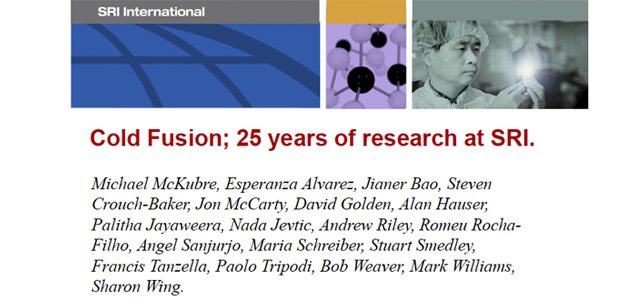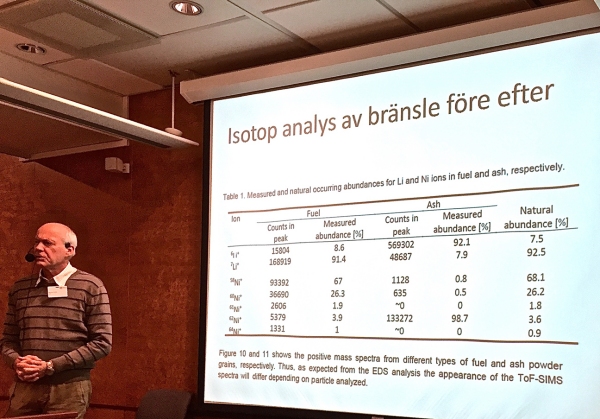Dr. Michael McKubre describes his career researching cold fusion/LENR/CMNS at SRI, in Cold Fusion; 25 years of research at SRI presented November 5, 2014 in Oslo, Norway.
Presentation slides are here from lenr-canr.org.
A description of the visit was published by Infinite Energy Magazine.
The Norwegian Academy of Technological Sciences (NTVA) and The Norwegian Society of Graduate Technical and Scientific Professionals (Tekna) sponsored the event as part of a one-day seminar Can LENR provide cheap and clean energy? drawing a capacity-crowd of around 60 people.
Former-head of Norway Defense Research Establishment and Nuclear Engineer Nils Holme chaired the committee, inviting speakers Sten Bergman of Stone Power AB in Sweden, and Hanno Essén of the Department of Mechanics, Royal Institute of Technology (KTH), Stockholm, Sweden, and Øystein Noreng, an economist from Norway.
Photo: Hanno Essen speaking in Oslo. Courtesy Infinite Energy Magazine
Hanno Essen, the past Chair of the Swedish Skeptics Society, recently released a report describing tests made of the E-Cat reactor, and spoke about “the various Rossi replications”.
Sten Bergman represented the energy industry perspective on LENR and Øystein Noreng spoke on “economic and other challenges of bringing any kind of LENR technology to the marketplace.”
McKubre also gave “the up-to-date status of Brillouin Energy’s latest technical progress”. SRI has been working with Brillouin Energy Corp. on the testing and design of an evolving energy cell. The design’s on-demand control of the reaction needs only a higher thermal output to be commercially viable.

McKubre lists Blacklight Power, Francesco Piantelli, Andrea Rossi, Defkalion, and Brillouin Energy Corporation all as working towards a commercial product using “small dimension nickel” and light-hydrogen. As small start-ups try to piece together a product, smart communities are preparing for a world without fossil fuels. McKubre writes that the seminar was called for to help Scandinavians educate themselves and plan for a future after the rich, local oil and gas resources run out.
“The object was to inform the possibility that Martin Fleischmann was right (and, by implication, Randy Mills, Mel Miles, Francesco Piantelli, Les Case, Yoshio Arata, Andrea Rossi, Tadahiko Mizuno, Defkalion, Brillouin and a host of others afterwards),” writes McKubre.

“This is a reasonable and rational approach that I certainly support. Let me say that more strongly. Any major country or company that does not engage now, or soon, runs a serious risk of missing the start of the revolution and being trampled.”
“That is not to say that I know that LENR will contribute significantly to primary power generation in any form in the near future, or that I know how.
But having studied the field closely now for more than 25 years (more than 35 years if you count our earlier studies of the Pd-D system for other reasons), nothing I know stands as significant impediment to this achievement…
… and the hoped-for goal of the “good guys” appears to be rapidly approaching. For a long time now corporations have been “lining up to be second” — afraid of the stigma, afraid to be left behind, but with insufficient courage to go first.[2]”
“With this in mind the Norwegian strategy of “hedging” seems to be entirely appropriate with no risk attached and very little cost associated. In the worst case young people can be trained in relevant disciplines of physical sciences and physics that will have high value in a wide range of applications and implementations. In the best case Norway, Sweden and whichever Nordic country chooses to be involved can position themselves to be at or near the front of the coming wave.”
Read the full article here compliments Infinite Energy Magazine.
Download the presentation slides here on lenr-canr.org.



I think that the institutions that were the biggest impediments to CF/LENR will try their best to disconnect what F&P did in 1989 from the reactors that are about to go commercial and hope that people who don’t know the history will not see the connection. I expect to hear more “Fleischmann and Ponzi ha ha” jokes.
http://gbgoble.kinja.com/contemporary-lenr-patents-popularly-known-as-cold-fus-1644173145
There were 5,135 inventions that were under secrecy orders at the end of Fiscal Year 2010. (US)
.
Significant from the data: “Thus, the 1971 list indicates that patents for solar photovoltaic generators were subject to review and possible restriction if the photovoltaics were more than 20% efficient. Energy conversion systems were likewise subject to review and possible restriction if they offered conversion efficiencies “in excess of 70-80%.” -end quote
.
“Invention Secrecy Still Going Strong” Posted on Oct.21, 2010 in Secrecy by Steven Aftergood
http://fas.org/blogs/secrecy/2010/10/invention_secrecy_2010/
.
There were 5,135 inventions that were under secrecy orders at the end of Fiscal Year 2010, the U.S. Patent and Trademark Office told Secrecy News last week. It’s a 1% rise over the year before, and the highest total in more than a decade.
.
Under the Invention Secrecy Act of 1951, patent applications on new inventions can be subject to secrecy orders restricting their publication if government agencies believe that disclosure would be “detrimental to the national security.”
.
The current list of technology areas that is used to screen patent applications for possible restriction under the Invention Secrecy Act is not publicly available and has been denied under the Freedom of Information Act. (An appeal is pending.) But a previous list dated 1971 and obtained by researcher Michael Ravnitzky is available here.
.
Thus, the 1971 list indicates that patents for solar photovoltaic generators were subject to review and possible restriction if the photovoltaics were more than 20% efficient. Energy conversion systems were likewise subject to review and possible restriction if they offered conversion efficiencies “in excess of 70-80%.”
.
One may fairly ask if disclosure of such technologies could really have been “detrimental to the national security,” or whether the opposite would be closer to the truth. One may further ask what comparable advances in technology may be subject to restriction and non-disclosure today. But no answers are forthcoming, and the invention secrecy system persists with no discernible external review. – end quotes
.
DIA-08-0911-003 13 November 2009
“Technology Forecast: Worldwide Research on Low-Energy Nuclear Reactions Increasing and Gaining Acceptance” http://lenr-canr.org/acrobat/BarnhartBtechnology.pdf
.
Quote…
.
“Because nuclear fusion releases 10 million times more energy per unit mass than does liquid transportation fuel, the military potential of such high-energy-density power sources is enormous. And since the U.S. military is the largest user of liquid fuel for transportation, LENR power sources could produce the greatest transformation of the battlefield for U.S. forces since the transition from horsepower to gasoline power.” -end quote
.
WOW, that’s a huge statement showing why LENR is definitively (defines the essence of) a matter of U.S. security.
.
The U.S. Defense Intelligence Agency (DIA) reports to the U.S. Commander in Chief and the Joint Chiefs of Staff. Every president of the U.S. has engaged advanced LENR research as a matter of national security, with all the efforts that this requires and entails, even down to patent office details.